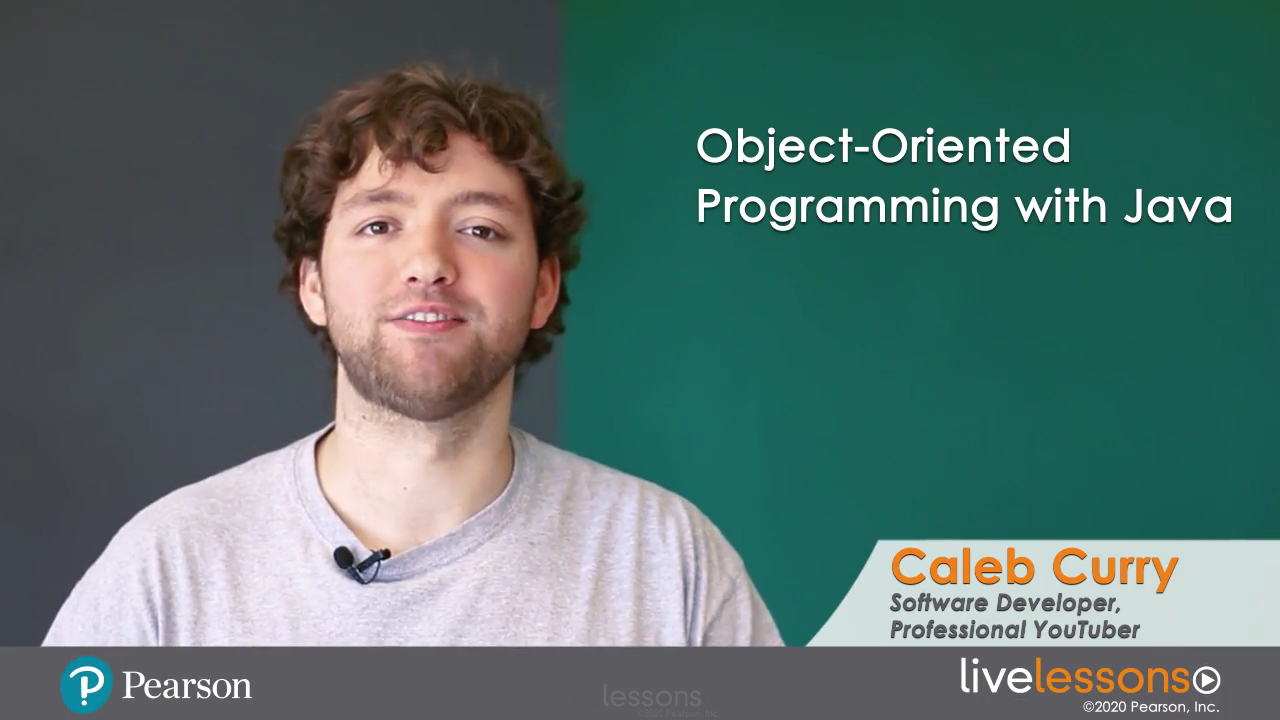Object-Oriented Programming with Java LiveLessons
- By Caleb Curry
- Published Jul 3, 2020 by Addison-Wesley Professional.

Online Video
- Your Price: $239.99
- List Price: $299.99
- About this video
Video accessible from your Account page after purchase.
Register your product to gain access to bonus material or receive a coupon.
Description
- Copyright 2021
- Edition: 1st
- Online Video
- ISBN-10: 0-13-679821-7
- ISBN-13: 978-0-13-679821-7
5+ Hours of Video Instruction
Java was introduced to the open-source community more than 20 years ago, and it remains popular among developers. However, we now live in a world dominated by the cloud, mobile, IoT, and open source, where containers, Kubernetes, microservices, reactive, and cloud-native application development can deliver higher levels of productivity and efficiency. That's where OOP concepts take center stage, and what Caleb concentrates on in this LiveLessons.
Description
In Object-Oriented Programming with Java LiveLessons, Caleb Curry provides the foundational instruction on OOP design principles and concepts, applying them in Java, so that programmers can overcome the challenges of starting or moving to OOP. Because modern languages are designed for scalability, Caleb describes how to think about coding with scalability in mind. He introduces classes, objects, methods, fields, access modifiers, encapsulation, polymorphism, and inheritance.
He also covers some of the best practices around exception handling in the context of object-oriented programming for Java up through Java SE 14.
Skill Level
- Beginning to Intermediate
What You Will Learn
- Learn the common terminology of object-oriented programming
- Develop example code for the main keywords
- Learn how the Java language is structured to build code to your full potential
- Build Java applications that use object-oriented principles
- Learn to encapsulate data using various Java keywords
- Design an inheritance hierarchy and implement it in code
- Understand polymorphism and how to get the most from your inheritance hierarchy
- Conquer the vast number of access modifiers to ensure the integrity of your code
Who Should Take This Course
- Programmers
- Developers (getting started with OOP concepts, but aware of programming in general)
Course RequirementsPrerequisites:
- Familiarity with the key concepts of programming, such as variables, loops, and functions
- Basic understanding of Java
About Pearson Video Training
Pearson publishes expert-led video tutorials covering a wide selection of technology topics designed to teach you the skills you need to succeed. These professional and personal technology videos feature world-leading author instructors published by your trusted technology brands: Addison-Wesley, Cisco Press, Pearson IT Certification, Prentice Hall, Sams, and Que Topics include IT Certification, Network Security, Cisco Technology, Programming, Web Development, Mobile Development, and more. Learn more about Pearson Video training at http://www.informit.com/video.
Video Lessons are available for download for offline viewing within the streaming format. Look for the green arrow in each lesson.
Sample Content
Table of Contents
Introduction
Lesson 1: Get Up to Speed with Java
1.1 Set up the Environment
1.2 Learn the Essential Data Types
1.3 Implement Control Flow
1.4 Understand Packages
1.5 Explore Exceptions
Lesson 2: Build the OOP Foundation
2.1 Create Classes
2.2 Instantiate Objects
2.3 Differentiate between Primitives and Objects
2.4 Work with Existing Objects and Classes in Java
2.5 Experiment with Default Values
Lesson 3: Make Methods for Classes
3.1 Create Methods
3.2 Differentiate between Arguments and Parameters
3.3 Test Java’s Pass by Value
3.4 Implement Method Overloading
3.5 Implement Method Overriding
Lesson 4: Work with Data Members
4.1 Create Fields in our Class
4.2 Define Constructors
4.3 Implement Getters and Setters
4.4 Test Java’s Access Modifiers
4.5 Understand the Static Keyword
Lesson 5: Explore Inheritance
5.1 Define an Inheritance Hierarchy with Derived Classes
5.2 Understand Interfaces
5.3 Differentiate between Virtual and Abstract
5.4 Create Final Classes
5.5 Work with Subclasses
Lesson 6: Work with Collections, Generics, and Polymorphism
6.1 Work with Collections and Generics
6.2 Work with Generic Lists
6.3 Implement Polymorphism
6.4 Create a Generic Class
6.5 Create a Generic Class for Multiple Types
Summary
More Information
